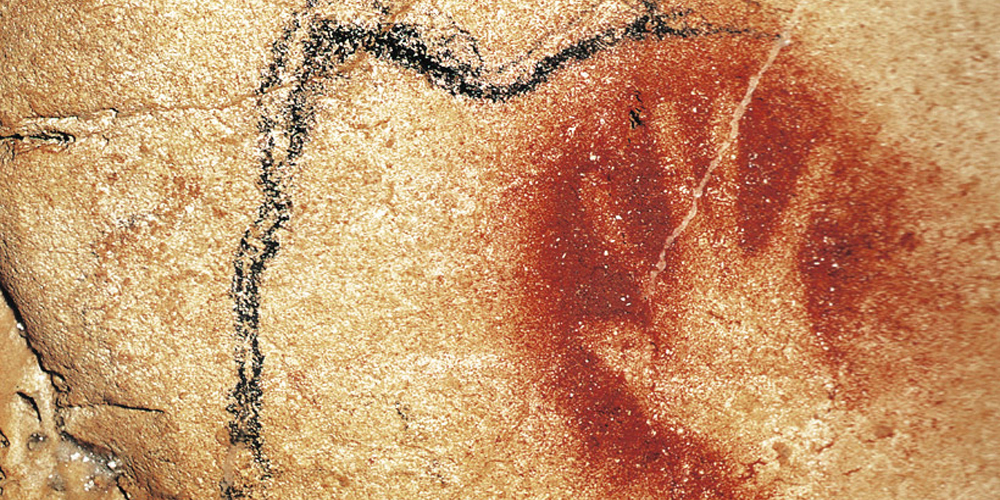


A recent article by Marianne Barriaux on seeker.com and AFP - To Unlock the Secrets of Prehistoric Hand Paintings, Experts Catalog Them in 3D - reports on the current archaeological research on Europe's prehistoric painted hands using scans and high-resolution photos.

A hand painting from Maltravieso Cave (left) in Cáceres, Spain. Image: Handpas. The entrance to Maltravieso Cave. Image: Mario Modesto.
Archaeologist Hipolito Collado and his team have been working in the Maltravieso Cave in the city of Caceres, western Spain, investigating the 57 hand stencils.
The Secrets of Prehistoric Hand Paintingshttps://t.co/roY53BpbIP #Chauvet #Palaeolithic #archaeology pic.twitter.com/XYBOWaofkC
— Bradshaw Foundation (@BradshawFND) May 12, 2017
The research raises obvious questions of purpose of this ancestral process: merely to make their mark, or part of a ritual to commune with spirits? And why are some fingers missing? Moreover, it raises the role of women during the Palaeolithic era.
To begin to address such issues, Collado, head of archaeology for the government of the Extremadura region where Caceres is located, has set out to catalogue all of Europe's prehistoric painted hands, taking scans and high-resolution photos. These are then posted in detailed, 3D format in a free-to-use online database, as part of an EU-funded project called Handpas.

A hand stencil in the Chauvet cave, France.
The idea is for researchers anywhere in the world to be able to examine them all in one place without having to visit every cave or gain access to those closed for conservation, in the hope of a greater understanding.
According to Collado, a Spaniard who is also head of the International Federation of Rock Art Organizations, painted hands have been found in 36 caves in Europe - all in France, Spain and Italy. Some also contain animal drawings and fossils but his project focuses only on hands.
Further afield, hands have also been discovered in South America, Australia and Indonesia, where recent research revealed that a hand silhouette in a cave on Sulawesi island was 40,000 years old - the world's oldest.
Researchers have tried to determine whether the hand prints were male or female. Can scientists determine for certain that all hands in one area were done by women? Collado's colleague Jose Ramon Bello Rodrigo suggests it could point to a matriarchal society.
And why in some cases fingers are missing? Regarding the latter, it is commonly believed they folded some fingers over when painting in some sort of sign language.
Did our Palaeolithic ancestors create the hand prints as a signature? No, suggests Paul Pettitt, professor of Paleolithic Archaeology at Britain's Durham University. His research focuses on where people placed their hands and he found that in some cases, fingers appeared to be deliberately placed over a bump in the wall like they were gripping it. He believes there was a definite purpose.
French prehistorian Jean Clottes believes it may have been a form of shamanism, stating that it is likely that putting paint - what we could call sacred paint - on the rock face introduces a link between the person who does it and the rock face, and therefore with the forces in the rock face.
Collado also interprets some of the hands he has seen as warnings, stating that in the La Garma Cave there is a panel with hands that is next to a big well that would be deadly. These were definitely done to say 'stop'.
Work on documenting painted hands in two Italian caves has also begun.
View more in Hand Paintings:
http://www.bradshawfoundation.com/hands/index.php
Handpas Project:
http://www.handpas.eu/en/
by Bradshaw Foundation
Monday 30 May 2022
by Bradshaw Foundation
Wednesday 19 January 2022
by Bradshaw Foundation
Thursday 06 January 2022
by Bradshaw Foundation
Monday 06 December 2021
by Bradshaw Foundation
Monday 29 November 2021
by Bradshaw Foundation
Monday 25 October 2021
by Bradshaw Foundation
Monday 12 July 2021
by Bradshaw Foundation
Monday 24 May 2021
by Bradshaw Foundation
Tuesday 20 April 2021
by Bradshaw Foundation
Thursday 01 April 2021
by Bradshaw Foundation
Tuesday 23 February 2021
by Bradshaw Foundation
Thursday 14 January 2021
by Bradshaw Foundation
Friday 18 December 2020
by Bradshaw Foundation
Sunday 06 December 2020
by Bradshaw Foundation
Thursday 26 November 2020
by Bradshaw Foundation
Wednesday 07 October 2020
by Bradshaw Foundation
Monday 30 May 2022
by Bradshaw Foundation
Wednesday 19 January 2022
by Bradshaw Foundation
Thursday 06 January 2022
by Bradshaw Foundation
Monday 06 December 2021
by Bradshaw Foundation
Monday 29 November 2021
by Bradshaw Foundation
Monday 25 October 2021
by Bradshaw Foundation
Monday 12 July 2021
by Bradshaw Foundation
Monday 24 May 2021
by Bradshaw Foundation
Tuesday 20 April 2021
by Bradshaw Foundation
Thursday 01 April 2021
by Bradshaw Foundation
Tuesday 23 February 2021
by Bradshaw Foundation
Thursday 14 January 2021
by Bradshaw Foundation
Friday 18 December 2020
by Bradshaw Foundation
Sunday 06 December 2020
by Bradshaw Foundation
Thursday 26 November 2020
by Bradshaw Foundation
Wednesday 07 October 2020
Friend of the Foundation











